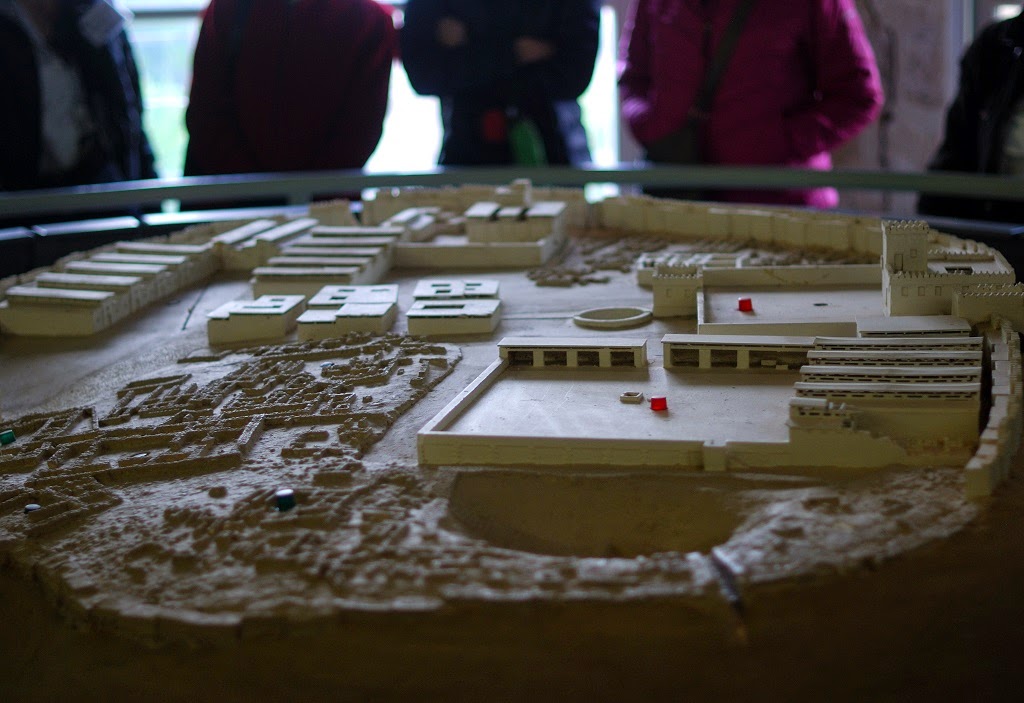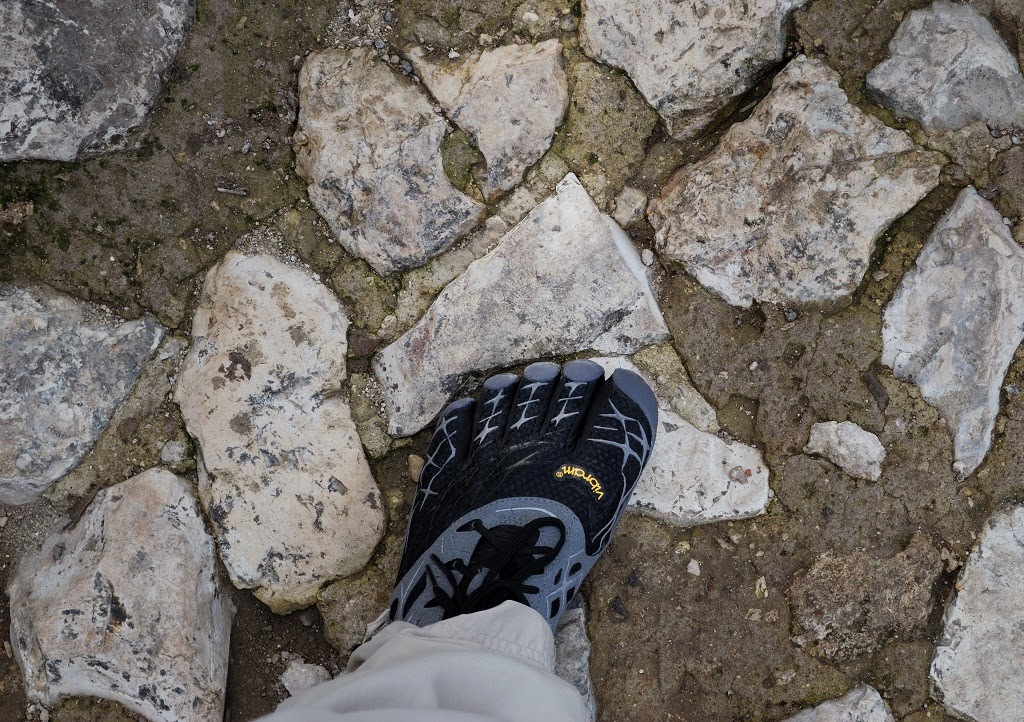So, picking up where we left off in Nazareth, we left the site of Mary's well and drove out of Nazareth toward the ruins of Megiddo. This took us south out of Nazareth and into the Jezreel valley, through the town of Afula and then west to the site of Tel Megiddo. (In Hebrew, Tel means "mound," particularly a mound with ruins on it.) Here is a view coming down from Nazareth into the Jezreel valley. Here we're looking to the south-southeast, toward the town of Nain where Jesus raised the widow's son.
After a 20 minute drive or so, we arrived at Tel Megiddo:
Megiddo is an ancient fortress built on top of a hill overlooking the intersection of two roads. There are several layers of history here that are too much to share with you in such a short time, but I will do my best. The oldest evidence of some kind of habitation at the site dates back to almost 7000 BC, so we're talking very very old. The site was occupied in some form until 586 BC, the time of the conquest by the Babylonians. This makes the site a rich archaeological site because later construction has not disturbed anything since that time. It's believed that the site functioned not only as a garrison and fortress, but that later construction during the time of Solomon included stables for some of his famed horses. This may have been a place where the horses were trained to work in pairs to pull chariots. Another main feature of the site we would get to experience is the tunnel that was dug to allow access to fresh spring water from inside the walls of the fortress. This is the inspiration for the fictional account of a well that is discovered in a tel in James Michener's famous novel "The Source." As we began our tour of the site, we gathered around this model of what the city may have looked like during the time of Solomon. The gates are out of frame to the left, some of the stables are in the upper left, the main fortress and palace is on the right with more stables in the right foreground, and the hole going down to the water tunnel is in the foreground. In front of the hole you can see a small crack in the wall that was first opened to allow quicker access to the spring before the hole and tunnel were dug. Before this, the women would have to leave through the front gates and walk around the walls of the fortress to get to the spring and draw the water, then carry it all the way back in through the gate.
Hopefully that gives you enough orientation, although we got a lot more detail than what I've given you here. As we entered the site itself, we passed by some of the original stairs leading up to the fortress. Remember, we're talking about things that are over 3000 years old!
As we walked through the ruins of the gates, our guide told us that we were now walking on the original stones from the 15th century, BC. I had to stop to take a picture of my foot on one of the stones, also to show you my shoes that everyone has been so interested in. I've got a separate blog about running and why I like these shoes, so I won't bore you with that now. Anyway, this is my foot on a stone that was placed here and walked on by ancient people at least 3500 years ago:
This is the view from the front gate of Megiddo looking back to the north across the Jezreel valley to Nazareth.
Here is Pastor Art charging through the gates of this impregnable fortress (this is what happens when the pastors are the last ones in the group):
Here is the rest of the group exploring the site as we make our way from the gates up to the first stables:
Here are the remains of the stables, again looking across the Jezreel valley toward Nazareth. Note that some of the stones are newer and were placed here to give you a more complete picture of the site. I included this picture mostly so you could see both Nazareth on the hillside in the distance on the middle left, but also Mount Tabor standing alone just to the right. This is most likely the Mount of Transfiguration. We won't travel there as it's a long journey by taxi to the top, but I thought it was nice to see. This also gives you an idea of why this fortress was so important with a commanding view of the entire valley. This is a good time to share with you the other reason this site is significant to us. In Revelation 16, when John says there will be a great massing of the armies of good and evil, he says it will take place at "Armageddon." This comes from the Hebrew "Har Megiddo" or "hill of Megiddo," so if you're wondering where the final battle between good and evil will occur, according to John it's going to take place right here in this valley.
As we left the stable area, we passed this strange round stone at the bottom of one of the more recent excavations. Our guide told us that it's solid basalt, and they're not sure what it's for, but it dates to the Bronze Age, or somewhere around 7000 BC, so it's evidence that there was a settlement here even then. They're doing more research about it before digging any deeper, so we're just kind of in awe of this strange ancient stone:
This area of the fortress was the cultic or ritual center, with the large circle of stones most likely being part of an altar for sacrifices, in Canaanite times (before they were conquered by the Israelites) perhaps even child sacrifice.
In the middle of the ruins, we were able to look inside the largest ancient grain silo that's been found in the Middle East. One farmer among us wondered if it was made by Sukup:
After seeing the other stables, it was time to descend into the well and walk through the ancient water tunnel to the spring on the outside of the fortress. As we decended the many stairs into the well, we saw the ancient stairs along the walls. These would have only gone down so far to a place where there would have been buckets to draw the water up, so the women would not have gone all the way down to the tunnel like we did. The tunnel simply brought the water from the spring outside the wall inside the fortress so they could draw it up. Our guide said that while this certainly saved the women many steps and protected them from attack, it was probably built more as a protection for the water source itself rather than out of concern for the women, although I'm sure they were glad for the "convenience" of it.
Like all tunnels, this one was of course rather dark, so the best I could manage picture-wise without using the flash was this closeup of the tunnel wall, hand dug of course:
After we emerged at the spring, we walked up more stairs (thankfully less on that side going up than we walked down from the inside of the fortress) to a parking area where our bus was waiting for us. We drove back to the main entrance and had our lunch at the cafeteria in the park. After lunch, we left Megiddo and went back east toward the Jordan River valley to Beth She'an, then north along the same road we took the evening before to Belvoir Fortress.
The name Belvoir is French meaning "good view" and it's appropriate, because to get there we drove up a winding road to the top of the hills overlooking the Jordan River valley. Belvoir is a Crusader fortress that was built in the 12th century AD as the Crusaders fortified themselves to defend against Muslim invaders. The fortress only lasted about 50 years until it was dismantled after coming under Muslim control. I decided I'd try to be a Crusader defender, too, if only for a moment. I don't think I would have fared any better than they did:
To get to the ruins, we first crossed the moat:
The architecture was exactly like what you'd expect from a typical Medieval castle with an outer wall, an inner wall, and then a fortified keep in the middle. Here is one of the arched entrances to the keep area:
This is looking east through the outer wall toward the hills of Gilead in modern day Jordan on the opposite side of the Jordan River.
Here is part of the view from the eastern wall of the fortress (without the wall, of course), giving you an idea of how commanding the vantage point was and why it was named "good view." This is looking northeast, with the Sea of Galilee on the far left and the hills of Jordan beyond the river valley to the right.
Crusad....I mean, Pastor Art, surveys the valley from his most recently conquered fortress of the day:
One final look across the valley from inside the fortress
On our way out of the fortress we stopped in the keep and took some more pictures, but we had to be somewhat quick about it because we were the last group of the day and the person at the gate said they were leaving at 4 whether we were gone or not :) That was the end of our touring for the day. We returned to Maagan and stopped at a shopping center along the way to buy some beverages, something our guide said she had never done with a group before. It was fun to go into an Israeli supermarket, and I bought some Israeli chocolate to bring home for Lindy and the boys. After that, it was time to head back to our resort to relax, enjoy supper, and get some rest before our big day around the Sea of Galilee that we had today. If I can get the pictures ready this evening I'll post about that in the morning before we leave Maagan and the Sea of Galilee and head toward Mt Carmel and the Mediterranean Sea at Caesarea before ending our day in Jerusalem, and since it's Friday evening here, I'll say farewell with the appropriate Jewish greeting: Shabbat shalom or "Peaceful Sabbath."
+PBK





















No comments:
Post a Comment